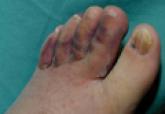Article

Mucocutaneous Presentation of Kaposi Sarcoma in an Asymptomatic Human Immunodeficiency Virus–Positive Man
- Author:
- Lisa M. Martorano, DO
- Jonathan D. Cannella, MD
- Jenifer R. Lloyd, DO
Kaposi sarcoma (KS) is a malignant proliferation of endothelial cells within the skin. The clinical presentation is characterized by clusters of...
